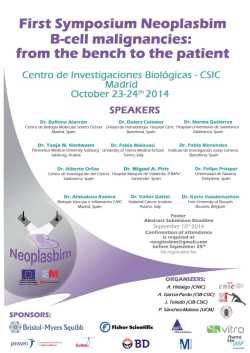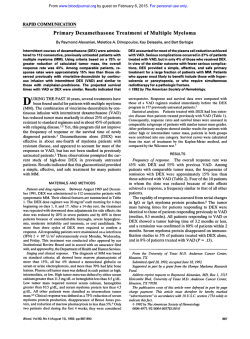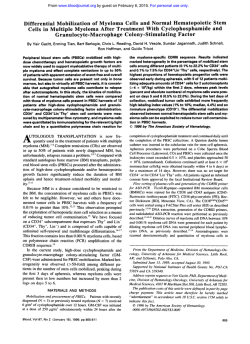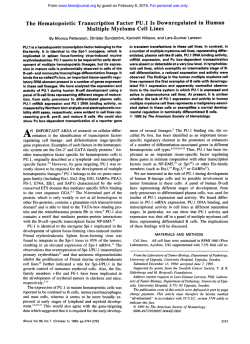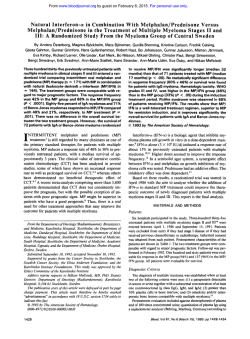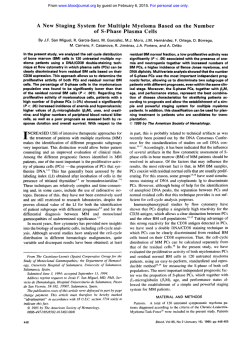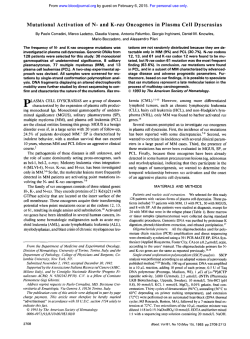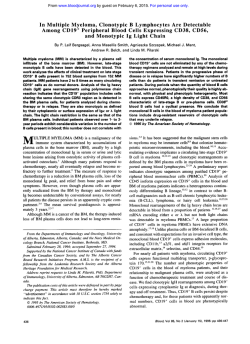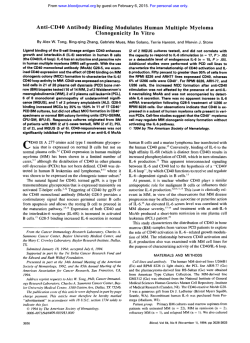
Human Myeloma Cell Lines as a Tool for Studying the
From www.bloodjournal.org by guest on February 6, 2015. For personal use only. 4001 CORRESPONDENCE Human Myeloma Cell Lines as a Tool for Studying the Biology of Multiple Myeloma: A Reappraisal 18 Years After To the Editor: Multiple myeloma (MM) is characterized by the expansion of malignant plasma cells (PCs) within the bone marrow. Although such malignant PCs can be easily identified by their high expression of CD38 and B-B4, their purification and in vitro expansion remain difficult. Therefore, established human myeloma cell lines (HMCL) are still essential to study the biology of MM. Eighteen years ago, it was elegantly documented by Nilsson' that the establishment of continuous cell lines from the bone marrow or the peripheral blood of MM patients actually leads to the obtention of two completely different types of cell lines, most frequently lymphoblastoid cell lines (LCL), which result from the immortalization of nonmalignant B cells by Epstein-Barr virus (EBV), and true HMCL, which represent the immortalization of tumor cells sharing the same Ig gene rearrangement as fresh tumor cells. We and others have recently reevaluated this critical point thoroughly and confirmed it?-5 Of note, some EBVf LCL established from the bone marrow of MM patients can produce Igs sharing the same isotype, public idiotype, and epitopic specificity (ie, anti-DNA) as the myeloma protein, although using completely different VL, VH, and CDR sequences, showing their complete inrelevance to the myeloma clone? A lot of studies devoted to the biology ofMM based on the use of several putative HMCL have recently been published. These interesting studies pointed towards major topics related to the MM biology. Clearly, the two types of cell lines, ie, LCL and HMCL, have been used indiscriminately in these studies, making some of the conclusions irrelevant to the biology of MM. Therefore, it appears very important to clearly establish the criteria for differentiating them. Based on recent phenotypic data?' the European Myeloma Research Network examined eight discriminant surface markers making it possible to determine the myeloma nature (or not) of the cell lines commercially available and routinely used in the majority of studies. Some XG HMCL recently established by ourselves have been included? As expected, the phenotypic analysis outlined in Table 1 shows clearly that two types of cell lines can be distinguished: (1) on the one hand, LCL, which are positive for CD19 and CD20, surface Ig, and the adhesion molecules CDlla and CD49e. but negative for B-B4 CD38 and CD28 molecules (ARH77, I"9, HS-Sultan, and MC-CAR); and (2) on the other hand, the other cell lines negative for CD19, CD20, CDlla, and CD49e but positive for the antigens characterizing the HMCL, ie, B-B4, CD38 and CD28. Attention has to be focused on the fact that one of these differentiation antigens is not sufficient to establish the nature of the cell line but that all these markers taken together allow an accurate conclusion. The clear-cut phenotypic dichotomy is also supported by the EBV status and the karyotype of these two types of cell lines, which have been previously published. Indeed, the LCL have all been described as EBV+ and present karyotypes completely contrasting with those of HMCL,"~" which are EBV- and have many and complex (hut recurrent) chromosomal abnormalities identical to those of fresh tumor cells.'* Moreover, it should be noticed that no From www.bloodjournal.org by guest on February 6, 2015. For personal use only. 4002 CORRESPONDENCE Table 1. Comparative Phenotypic Analysis of Myeloma and Lymphoblastoid Cell Lines Surface lg HMCL XG 1 XG 2 XG 6 U266 RPM1 8226 LP1 L363 OPM2 NCLH929 LCL ARH-77 IM9 HS-Sultan MC/CAR CD38 6-6, K ++ ++ ++ +/- - +++ - +l.+/- - - - - - - - - ++ ++ + + +++ +++ +++ ++ +++ +++ h CD28 CD19 CD20 CDlla + - - - ++ + ++ ++ + ++ - - - - + + - + + +/+l- ++ - + - - - ++ + + +/- - - +l- - + - - +++ + direct proof has ever been published that the LCL harbor the same karyotypic abnormalities and/or Ig gene rearrangements as primary tumor cells in the patients from whom they were derived. Considering that the LCL ARH-77, IM9, HS-Sultan, and MCCAR listed at the ATCC as HMCL have been used frequently in recent reports to study the biology of MM (in place of HMCL), we would like to address some concerns about the conclusions related to the studies regarding (1) the expression of adhesion molecules by myeloma cells and the interaction of myeloma cells with stromal cells through these adhesion molecules; (2) the mechanisms of bone disease in MM; (3) the role of the CD40 molecule in MM; and (4) the role of soluble CD16 in MM as relevant to the biology of MM. Catherine Pellat-Deceunynk Martine Amiot RCgis Bataille Laboratoire d’Oncogkn2se Immunoh&matologique Institut de Biologie Nantes, France Ivan Van Riet Benjamin Van Camp Laboratory of Hematology and Immunology Free University of Brussels Brussels, Belgium Paola Omede Mario Boccadoro Laboratorio Divisione di Ematologia Universita ’ Di Torino Torino, Italy Biomed Program (BMHI-CT93-1407) REFERENCES 1. Nilsson K: Established cell lines as tools in the study of human lymphoma and myeloma cell characteristics. Haematol Blood Transfus 20:253, 1977 2. Gazdar AF, Oie HK, Kirsch IR, Hollis GF: Establishment and characterization of a human plasma cell myeloma culture having a rearranged cellular myc proto-oncogene. Blood 67:1542, 1986 - - - - - + CD49e - - - - - - - +/- + - - - - - - - - - - - - - - + ++ ++ ++ ++ + +++ + + + + + + +/- ++ + 3. Diehl V, Schaadt M, Kirchner H, Hellriegel KP, Gudat F, Fonatsch C, Laskewitze E, Guggenheim R: Long-term cultivation of plasma cell leukemia cells and autologous lymphoblasts (LCL) in vitro: A comparative study. Blut 36:331, 1978 4. Goldstein M, Hoxie J, Zernbrykid D, Matthewq D, Levinson AI: Phenotypic and functional analysis of B cell lines from patients with multiple myeloma. Blood 66:444, 1985 5. Commes T, Clofent G, Ghanem N, Zbang XG, Lefranc MP, Bataille R, Klein B: Analysis of the B-cell compartment in plasma cell leukemia and multiple myeloma: Immunoglobulin gene rearrangement of EBV-infected B-cell lines. Leukemia 7:609, 1993 6. Davidson A, Manheimer-Lory A, Aranow C, Peterson R, Hannigan N, Diamond B: Molecular characterization of a somatically mutated anti-DNA antibody bearing two systemic lupus erythematosus-related ihotypes. J Clin Invest 85:1401, 1990 7. Pellat-Deceunynck C, Bataille R, Robillard N, Harousseau JL, Rapp MJ, Juge-Morineau N, Wijdenes J, Amiot M: Expression of CD28 and CD40 in human myeloma cells: A comparative study with normal plasma cells. Blood 84:2597, 1994 8. Pellat-Deceunynck C, Barill6 S, Puthier D, Rapp MJ, Harousseau JL, Bataille R, Amiot M: Adhesion molecules on human myeloma cells: Significant changes in expression related to malignancy, tumor spreading and immortalization. Cancer Res 55:3647, 1995 9. Zhang XG, Gaillard JP, Robillard N, Lu ZY, Gu ZJ, Jourdan M, Boiron JM, Bataille R, KleinB: Reproducible obtaining of human myeloma cell lines as a model for tumor stem cell study in human multiple myeloma. Blood 83:3654, 1994 10. Rittz RE, Ruiz-Arguelles A, Weyl KG, Bradley AL, Weihmeir B, Jacobsen DJ, Strehlo BL: Establishment and characterization of a human non-secretory plasmacytoid cell line and its hybridization with human B cells. Int J Cancer 31: 133, 1983 11. Drewinko B, Mars W, Minowada J, Burk KH, Trujillo JM: ARH-77, an established human IgG-producing myeloma cell line. I. Morphology, B-cell phenotypic marker profile, and expression of Epstein-Barr virus. Cancer 54:1883, 1984 12. Jemberg H, Zech L, Nilsson K: Cytogenetic studies on human myeloma cell lines. Int J Cancer 40:811, 1987 From www.bloodjournal.org by guest on February 6, 2015. For personal use only. 1995 86: 4001-4002 Human myeloma cell lines as a tool for studying the biology of multiple myeloma: a reappraisal 18 years after [letter] C Pellat-Deceunynk, M Amiot, R Bataille, I Van Riet, B Van Camp, P Omede and M Boccadoro Updated information and services can be found at: http://www.bloodjournal.org/content/86/10/4001.citation.full.html Articles on similar topics can be found in the following Blood collections Information about reproducing this article in parts or in its entirety may be found online at: http://www.bloodjournal.org/site/misc/rights.xhtml#repub_requests Information about ordering reprints may be found online at: http://www.bloodjournal.org/site/misc/rights.xhtml#reprints Information about subscriptions and ASH membership may be found online at: http://www.bloodjournal.org/site/subscriptions/index.xhtml Blood (print ISSN 0006-4971, online ISSN 1528-0020), is published weekly by the American Society of Hematology, 2021 L St, NW, Suite 900, Washington DC 20036. Copyright 2011 by The American Society of Hematology; all rights reserved.
© Copyright 2026
